Deliciosa is one of the most popular house plants on the planet, with a simple beauty that is almost as charming as it’s alternative title; Swiss Cheese Plant.
When I moved into my own home, what feels like a lifetime ago, it was the first plant I bought, having read it was essentially unkillable, so I placed it on a bright windowsill, and watered it whenever the soil was dry.
After a few weeks, I noticed the leaves curling, and brown tips appearing on every leaf. Needless to say, I’d managed to put my Monstera in the only place it didn’t like.
Ten years later, that same plant is growing happily with no residual signs of my early mistakes. The following sections of this article are a guide for how to grow Monstera deliciosa, written by someone who has a wealth of trial and error experience, so you can learn from my mistakes before you make your own.
More...
What is Monstera deliciosa?

Monstera, like most of our favourite houseplants, is part of the Araceae family. The family includes Philodendron, Dumb Cane and Epipremium (Pothos), but for me, the variety of Monstera in cultivation makes it a much more exciting option for growers.
Swiss Cheese Plant’s natural habitat is tropical rainforest floors, where they can reach up to 70 foot tall by rooting into the bark of trees.
Their roots are referred to as semi-epiphytic, meaning they send roots out from their stems, and use them to anchor the plant as well as draw in moisture, in combination with ground roots (epiphytic plants use their roots almost entirely for moisture, like Tillandsia).
Their location on rainforest floors also gives us a clue to their appearance. Their leaves have an abundance of naturally occurring holes called fenestrations (hence Swiss Cheese Plant) that have evolved to help the plant withstand high winds and heavy rainfall.
The holes allow water to fall through the leaves rather than weigh them down, as well as stopping the leaves acting as a sail in the wind. Young leaves grow without holes, and develop them as they mature.
Monstera deliciosa has a slightly perplexing name in the views of most growers, as it is incredibly rare to see its fruit, but if you are ever fortunate enough, nurture it.
The unique flavour has earned it the title of Fruit Salad Plant across the world, as its fruit shares the flavours of banana, guava, mango, strawberry and pineapple. Which makes sense why Monstera deliciosa is given its name; it’s delicious.
Sadly, you’re unlikely to see this fruit on a houseplant, as they require absolutely perfect conditions, similar to its natural habitat on the forest floor. Even then, they only fruit every twelve years, and Monstera fruit takes over a year to ripen.
How to Grow Monstera deliciosa
Monstera deliciosa grow on tropical forest floors, this means they like heat, moisture, humidity and dappled light. There are hundreds of articles online suggesting growing Monstera in bright light, but from experience, it can lead to overwhelming leaf scorch, even in colder climates.
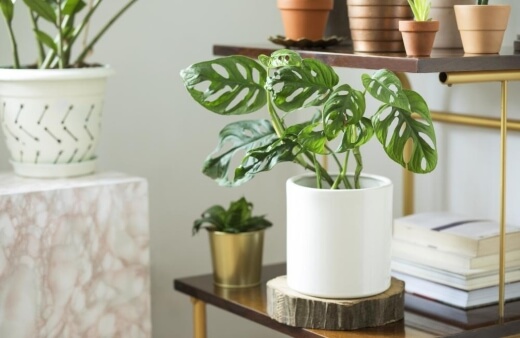
By far the best place to leave your plant is a bright bathroom slightly away from the window, for the increased humidity and controllable light levels, but if you’re limited on space, like I am, an occasional mist spray will do the trick.


Get Your Free Guide:
Master Growing Australian Natives eBook
A Must Have Complete Guide for Every Australian Garden
Get Your Free Guide:
Master Growing Australian Natives eBook
A Must Have Complete Guide for Every Australian Garden
Below, I’ve broken down some of the key factors to how to grow Monstera so you can get each one right, step by step.
Monstera Sunlight Requirements
Monstera needs dappled light, so growing it in the shade of another houseplant is ideal, but failing that, you can simply keep it a few metres away from the window.
There is no need to turn your Monstera to face the sun as its leaves turn by themselves to find the sun. If the plant ever grows out in one direction, turning the pot or plant stand for a few weeks will encourage it to turn its head around and even up.
Read up on the best ways to use led grow lights for your indoor plants. You will need them to get the best results.
Temperature Requirements
Swiss Cheese Plants are very easy going with temperatures, and will tolerate 65-85°F (18-29°C). So, wherever you are in Australia there should be somewhere in your house where the plant will always be happy.
In hotter climates, keep your Monstera in a shaded room. In cooler climates, keep it in a sunny spot, slightly away from the window.
Monstera Humidity Requirements
Monstera grow in warm wet conditions in their natural habitat, so some humidity is required to keep them happy and healthy, but it’s also a great way to keep the leaves looking their best.
If you have your Monstera in a bathroom, there is no need for extra humidity, but if it’s near a window, air conditioning unit, or door, you will definitely need to mist your Monstera every 1-2 weeks.
Their leaves lose water during their peak growing season in summer. In fact, you’ll notice that a healthy Monstera will have water droplets mysteriously appearing in the mornings and evenings on the end of each leaf.
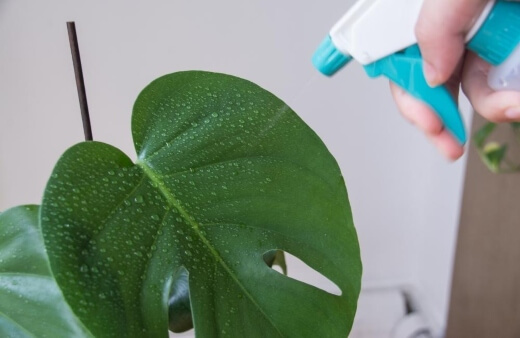
Watering Monstera
The easiest way to know when your Monstera is dry is to dip you finger into the soil. If it’s dry, it needs watering, if there is any moisture, let it use it up. Find out which is the best water to use for plants here.
The only way you will completely kill a Monstera is to over-water. Root rot is one of the few problems these plants suffer, so water when it needs it, no more. There are some great tools you can get to help keep on top of this, which we’ll cover later on.
Best Soil for Swiss Cheess Plant
Monstera needs well drained natural matter to grow happily. A decent potting mix from your local garden centre will be perfect, but if you want to mix your own, garden compost, or a peat-free shop-bought compost, with a little vermiculite will be perfect.
If your too busy to mix your own, check out our review on the best potting mix available in Australia. You can add bark chippings (like to orchid bark) to loosen up the soil if it feels too heavy.
Because of their aerial roots, a well misted Monstera doesn’t grow its ground roots very quickly at all, so when you buy your plant, gently tip it out of the pot. If the roots have not yet filled the pot, it’s probably happy there.
Only pot Monstera up when its roots are showing at the bottom of the pot, and then pot up one size, to a pot that is 1-2 inches larger.
Tools for Growing Monstera deliciosa
Mister
The essential tool that most houseplant parents forget about is the humble mister. Keeping the leaves and aerial roots of your Monstera misted keeps it happy, healthy and clean.
The same goes for almost all tropical house plants, so investing in a good mister is essential for house houseplant care. Depending on how many houseplants you’re watering, there are two choices:
- Hand-mister. A basic mister is all you need for a few plants, and will easily do the job. You can get basic misters, or even clean out old cleaning spray bottles. The main purpose is to help regulate the humidity of the plant.
- Garden backpack sprayer. If, like me, you’re a compulsive houseplant buyer, something more heavy duty is going to be necessary, and a hand pumped pressure sprayer will make your job easier.
The idea being that you can water and mist at the same time, which is a good way to keep plants watered and humid. We use ours once a week in summer, which is plenty.
(If you don't have one yet, our review on the best backpack sprayer will help you get one that'll suit your needs.)

Indoor Watering Can
Your Monstera needs to dry out between each watering to avoid root rot, so a decent sized watering can is needed, to make sure you water enough that the water runs through the bottom of the pot each time. Water generously, not ‘little and often’.
Houseplant Scissors or Secateurs
Scissors will do most pruning jobs on Monstera, but occasionally you might need something more substantial if you decide to drastically cut back a main stem on your Swiss Cheese Plant.
A great pair of secateurs is indispensable for indoor gardens. Read our best secateurs buying guide here.
Moss pole
Moss poles are moss poles. There is no such thing as a good one or a bad one, as long as their surface is covered in coir or moss, your Monstera will be happy.
Their purpose is to provide the most natural environment possible in your home, providing a good surface for aerial roots to grab on to.
You can easily build your own custom moss poles too with a length of old pipe and a coir sheet tied on with twine (even customize it with a few pipe angles for something more unique).
Fertiliser
Unless you grow dozens and dozens of houseplants, buying fertilisers readymade is the easiest option, as it won’t spoil. Any standard houseplant fertiliser will do the trick, but the easiest way to keep Monstera happy is to blend a banana skin with hot water, and pour it on once it’s cooled.
For readymade fertilisers, read our complete garden fertiliser users guide here.
Watering Meter
Watering sensors, and moisture meters come in all shapes and prices, but for a Monstera, a budget option is fine, but you don’t actually need to spend a penny.
An old broken terracotta pot will tell you when the soil is dry, as you can see the moisture on its surface. Just bury a cracked piece of terracotta 2-3 inches into the soil, and if it’s darker than normal, the soil is moist.
There are many moisture meters available online. To make it easier for you to choose one, here is our soil moisture meter buying guide.
Caring for Swiss Cheese Plant
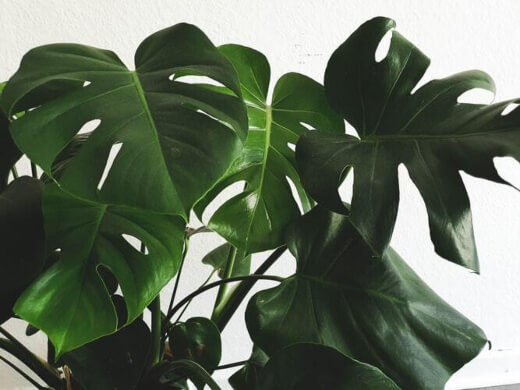
Fertilising Monstera deliciosa
Monstera will benefit from either a basic house plant feed, or a homemade feed. For most houseplant parents, a simple feed like liquid seaweed will do the trick as one bottle can easily last an entire year for a handful of plants, but for avid collectors, making your own feed can be a huge money saver.
The easiest way to feed you plants is either cleaned egg shells, or banana peel. With each, you can chop/grind them and lay them directly on the soil for a slow release, or make a tea by steeping overnight in boiling water.
When the water has cooled, you’ll have a great calcium and potassium rich tea which will go straight to the roots.
Pruning Monstera deliciosa
Monstera deliciosa are very forgiving plants, so there’s no need to stress about pruning them. Just get a pair of sharp scissors (their stems are easy to cut), and cut wherever you need.
As long as you cut back to a bud, or a leaf node (where the leaf joins the main stem) you can’t go wrong. If you want to get rid of an entire stem, that’s fine too. The more mature the plant is, the faster it will grow back.
For a five-year-old plant, you could cut it back to the ground, and it will grow back – I’m not advising that, but just to illustrate that you really can’t go wrong when pruning Monstera.
Supporting Monstera deliciosa
Monstera are often sold with moss poles. As a semi-epiphyte, they will cling on to any surface they are given, and can dig their roots right into the surface of the pole, sometimes growing right through the other side.
Monstera don’t draw nutrients through these roots unless they are struggling at their base, so other options can be training them up wire, or indoor trellis. If you choose this option, they will need tying in to their supports.
The benefit of moss poles is that they help the plant mimic its natural environment, and support itself. The negative of moss poles is that your Monstera will quickly outgrow them, and it can be quite a fiddly job to detach the plant from the old pole, leading to snapped roots.
The best way to support your Monstera long-term is to give it a moss pole that is equal to the ultimate height you want the plant to reach. It will cover the pole eventually, and be easy to prune when it reaches the height you want.
How to Propagate Monstera deliciosa
Now, one of my favourite things about growing Monstera is that when you prune them, you are making new plants every time. Young Monstera make incredible gifts (and unlike some scarier high maintenance houseplants, aren’t an obligation to whoever receives them).
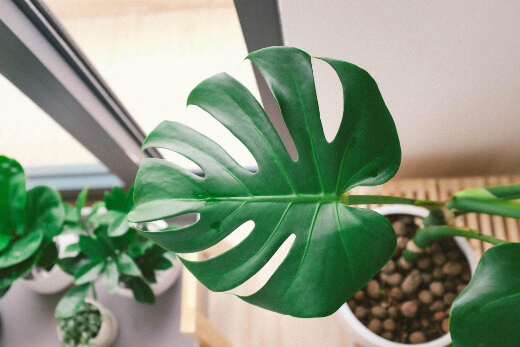
When you prune your Monstera, cut its stem back to where it meets a node, including two leaves in each cutting. Place that immediately in clean water (rain water is ideal), and wait until it has roots.
Voila! A new Monstera. For more detail on how to propagate Monstera and perfect results every time, read our guide on how to propagate Monstera here.
Common Monstera Pests & Diseases
Monstera can suffer a lot of uses, but other than root rot, they will bounce back from all of them.
Monstera Pests
Monstera can host spider mites and whiteflies, just as much as any other houseplant, but are resilient to their effects. Whiteflies are unsightly though, and can damage your other plants immensely.
For spider mites and whitefly, rubbing alcohol dabbed on with cotton buds will kill them instantly. Just make sure you rinse the plant afterwards. Using fly or insect sprays is incredibly ineffective with most houseplant pests, and it is best to manually remove the insects.
Monstera Diseases
Root Rot
Root rot in Monstera is the only problem that a Monstera will truly struggle to recover from. It is caused by fungal and bacterial growth in the soil, caused by damp, dark, humid conditions.
While your Monstera needs humidity to enjoy its life, that has to be combined with bright but indirect light, and reasonably high temperatures, ideally in excess of 18C.
By far the best way to avoid root rot in Monstera is free draining compost. Whenever you pot your Monstera on, make sure to add at least 30% vermiculite & orchid bark to 70% soil.
The soil should ideally be a good nutrient rich compost, but nothing water retentive like manure or peat, which can create boggy conditions if the temperatures drop.
To save a Monstera from root rot, there is only one solution. If it has multiple stems in one pot, tip the soil out of the pot, rinse off the roots, and discard anything with blackened roots or stems.
The remaining materials (hopefully with roots attached) will recover if watered properly in the right compost.
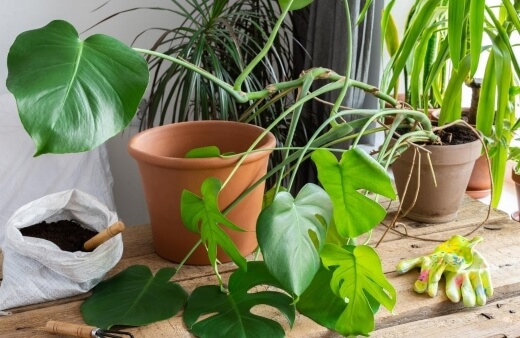
Monstera Leaf Curl
Monstera leaf curl can be an early indicator of root rot, but also an indicator that your Monstera is too dry. It always seems like a get out clause in plant care columns, but it should be easy to determine which one it is.
If it is too wet the soil will feel wet in the top two inches, rather than slightly moist. If it is too dry, the curl might be accompanied by paler leaves, or water running through the pot entirely.
If leaf curl is caused by over watering, simply scale back your watering for a few weeks and see if that helps. If the curl is caused by dryness, stand the pot in a tray of water to let it soak the water up from the base.
This will restore the compost, then return to watering routinely. One other option for Monstera leaf curl is excessive temperatures.
If you have yourMonstera near a radiator, or (as I mentioned at the start of this article) in full sun during a hot summer, it is probably just struggling with the heat, and not able to carry enough water to its leaves.
Don’t try to drown it, just move it to a slightly shadier spot, and water from the base by standing in a tray of water.
Leaf Droop
Leaf droop, like leaf curl in Monstera can be a warning sign of root rot. In that instance, you’ll be watering regularly, and have moist soil, but the roots don’t take any water up to the plant due to damage.
If the soil is moist, but the plant appears dry, remove soil from the roots and inspect them for root rot. It can make all the difference and you might catch it early by cutting off any effected roots before the fungus spreads.
Most of the time though, Monstera leaf droop is simply under watering or over-heating. Check the temperature, and if it’s over 28C, move your Monstera to a cooler room.
If it’s because the soil is bone dry, try watering as normal, but placing a tray underneath the pot so if water runs out, it is reabsorbed into the soil. While it’s not a permanent solution, it can help soil re-establish its structure over a few weeks.
Leaf Blackening / Browning
Black or brown leaves on your Monstera are a cause for concern. Black spots with yellow halos on Monstera are incredibly rare, but are an identifier of fungal disease.
Remove any affected areas, and spray the rest with a fungicide. Black tips on Monstera leaves are usually sunburned. If you’ve recently moved your plant into a sunnier position, just move it back and it should be ok. The black tips won’t recover so remove them.
Monstera leaves turning brown or black can mean a few different things, but slowly turning a uniform shade of brown or black is usually an indicator of under fertilisation.
You’ll know which because if you fertilise regularly, it’s over fertilisation. If the last time you fertilised was this time last year, it needs more adding, and it should recover.
Monstera Leaf Not Splitting
There is nothing at all wrong with a Monstera without hole. The main cause of Monstera without holes is that they are still young. Young Monstera can take up to a year to start developing their signature holes. Just be patient.
As discussed earlier though their holes are a reaction to tropical climates, so if you are growing them as a shady room plant, stop it. They like sun, just not direct sun.
Some of their natural habits can be postponed by restricting their access to sunlight, and growing holes is one of them.
Monstera Leaves Turning Yellow
Yellow leaves on a Monstera are, more often than not, just nature taking its course. Plants aren’t always at their best, and the best course of action with yellow leaves is to just cut them off down to the main stem.
They won’t recover and take energy away from the rest of the plant. The only possible cause is overwatering or drainage. Even if you water perfectly, the wrong soil can lead to build up of moisture.
Always add a croc or broken terracotta or stone over the hole at the base of your houseplant pots, unless they are specifically bog plants.
Monstera Swiss Cheese Plant FAQs

How do you know if your Monstera is happy?
The best indicator of a happy Monstera is regular growth of new leaves. If you see a new leaf appearing every 3-4 weeks, that’s a happy plant. They can grow rapidly in perfect conditions, so keep them pruned.
If your Monstera has stems where all leaves are missing their holes, there is nothing wrong with the plant, just cut the stem back to a leaf with holes, and it will regenerate with its proper habit.
Is Monstera a good indoor plant?
Monstera are a great indoor plant. They are one of the most popular houseplants in the world, and will tolerate most conditions.
Can you grow Monstera outdoors?
In most of Australia, Monstera will grow happily outdoors, and provided it has a host tree, or a wall with trellis can cover the side of a house.
They make incredible garden plants in warmer climates, but are not frost tolerant, so should be kept as a house plant in any areas where frost is a possibility.
Are Monstera safe for pets?
Monstera are toxic to cats and dogs. I have four cats, and a very large Monstera, but they have never been interested in eating it. We grow cat grass indoors, and a pot of catnip in the kitchen, which has always kept them away from the other house plants.
Cats will naturally eat grasses when they have upset stomachs, but are otherwise carnivorous, and are generally intelligent enough to not eat things that will harm them.
Dogs on the other hand, will eat anything in their path, so Monstera are best avoided in homes with dogs.
Does Monstera purify air?
Monstera is most effective in removing formaldehyde molecules caused by exhaust emissions from the air, but is also great at recycling carbon dioxide into Oxygen.
In a room where you prefer closed windows due to traffic noise, or temperature control, it is a great way to get fresh air into your home.
Wrapping Up Our Monstera Growing Guide
Monstera deliciosa, or Swiss Cheese Plant, are beautiful and fascinating plants that are easy to grow, and very hard to kill. One in particular we love the most is it's variegated variety so be sure to check our comprehensive Thai Constellation Monstera growing guide here.
Growing Monstera is one of the most rewarding things you can do in your home, just make sure you don’t over-water them, and keep them away from extreme sunlight.
These tips for growing Monstera above are all learned through failure, but my Monstera is thriving today, and has a gang of offspring to keep it company from propagated cuttings. I hope you find just as much joy from growing Monstera yourself.

Published on December 10, 2021 by Gary Clarke
Last Updated on February 15, 2025





Misting raises the humidity for about ten seconds. It’s really not effective for plants other than air plants. Especially pointless for leathery leafed plants like Monstera adapted to wet/dry tropics. Monstera deliciosa grow fine outdoors in my native Melbourne where it can be frosty or dry dry dry and really don’t mind warm sun once acclimatised – they may scorch on a really hot afternoon. They fruit in gardens a lot more than you claim, they just need to be pretty established. Their logs can lie dormant for years before being revived – have done so many times.
Hi Kiteo,
Thanks for this. We’ve always kept Monstera indoors where it really benefits from misting. More than anything, it helps to reduce transpiration from the leaves in dry conditions (air conditioning is awful for humidity so humidifiers or spray bottles help balance that out).
You’re right about outdoor Monstera though. Misting isn’t necessary unless they’re going through really, really bad drought, or subjected to high winds.
Best regards,
Gary Clarke